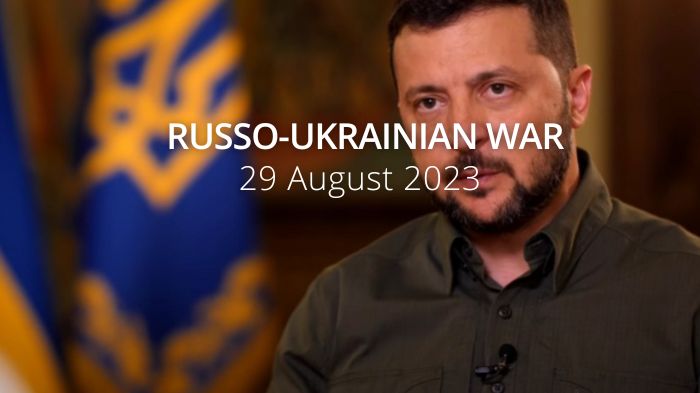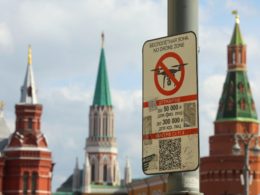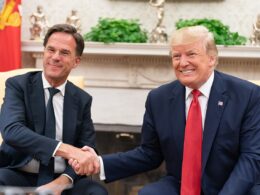Russia has concentrated over 100,000 troops in the Kupiansk-Lyman direction of the front in Kharkiv Oblast and Luhansk Oblast. Zelenskyy says he wants elections in 2024: billions and observers in trenches needed. Erdoğan's party confirms his visit to Putin.
Daily report day 552 – August 29 2023
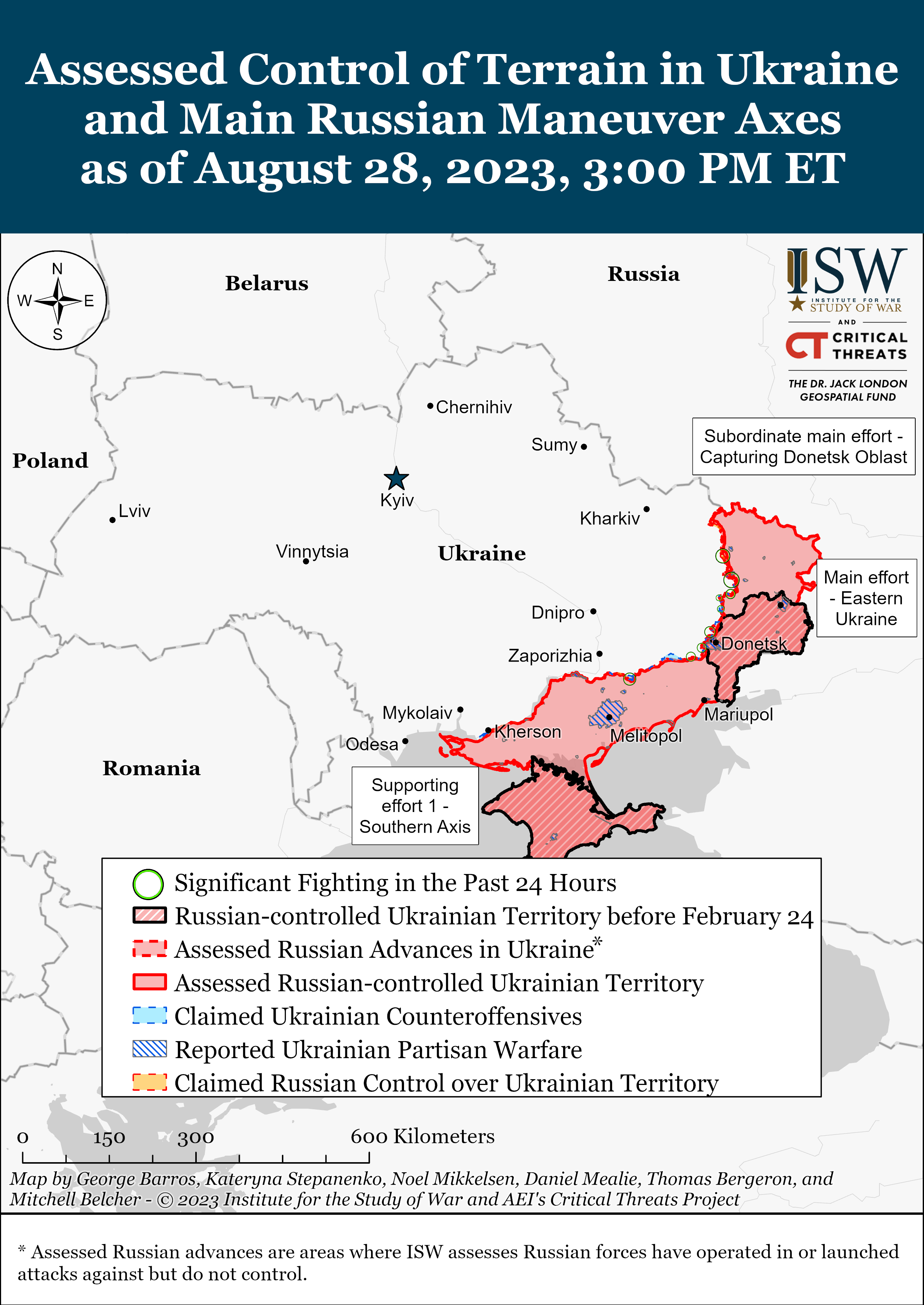
According to information from the General Staff as of 06.00 29.08.2023, supplemented by its [18:00 assessment].
“On August 28, the enemy launched 8 missiles and 47 airstrikes, 39 MLRS attacks at the positions of Ukrainian troops and various settlements. Unfortunately, the Russian terrorist attacks have killed and wounded civilians. Residential buildings, schools, and other civilian infrastructure were damaged.
The likelihood of missiles and airstrikes across Ukraine remains high.
On August 19, there were 32 combat engagements.
- Volyn and Polissya axes: no significant changes.
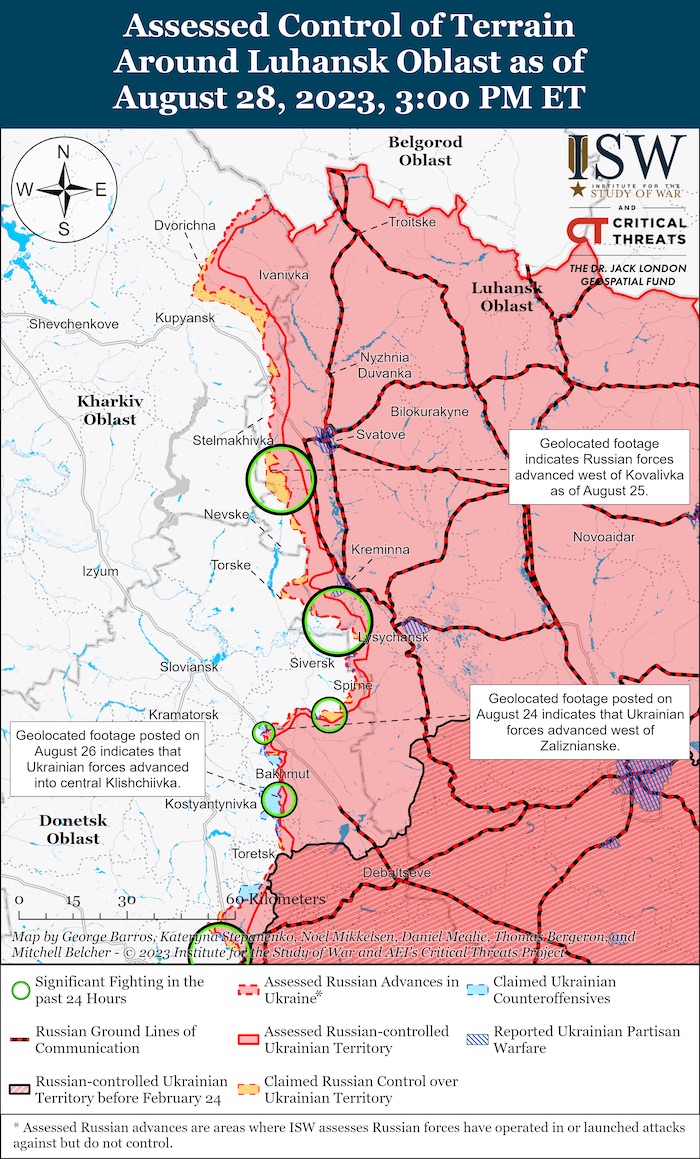
- Sivershchyna and Slobozhanshchyna axes: the adversary launched airstrikes in the vicinities of Popivka, Slavhorod (Sumy oblast), and Veterynarne (Kharkiv oblast). The adversary fired mortars and artillery at more than 25 settlements, including Karpovychi, Kamin’ (Chernihiv oblast), Volfyne, Boyaro-Lezhachi, Obody, Seredyna-Buda, Novodmytrivka, Popivka, Stukalivka (Sumy oblast), Mala Vovcha, Zybine, Okhrymivka, Vil’khuvatka, Veterynarne (Kharkiv oblast).
- Kupiansk axis: the adversary launched airstrikes in the vicinities of Ivanivka and Kyslivka (Kharkiv oblast). The settlements of Kyslivka, Kolodyazne, and Berestove (Kharkiv oblast) came under artillery and mortar fire from the adversary.
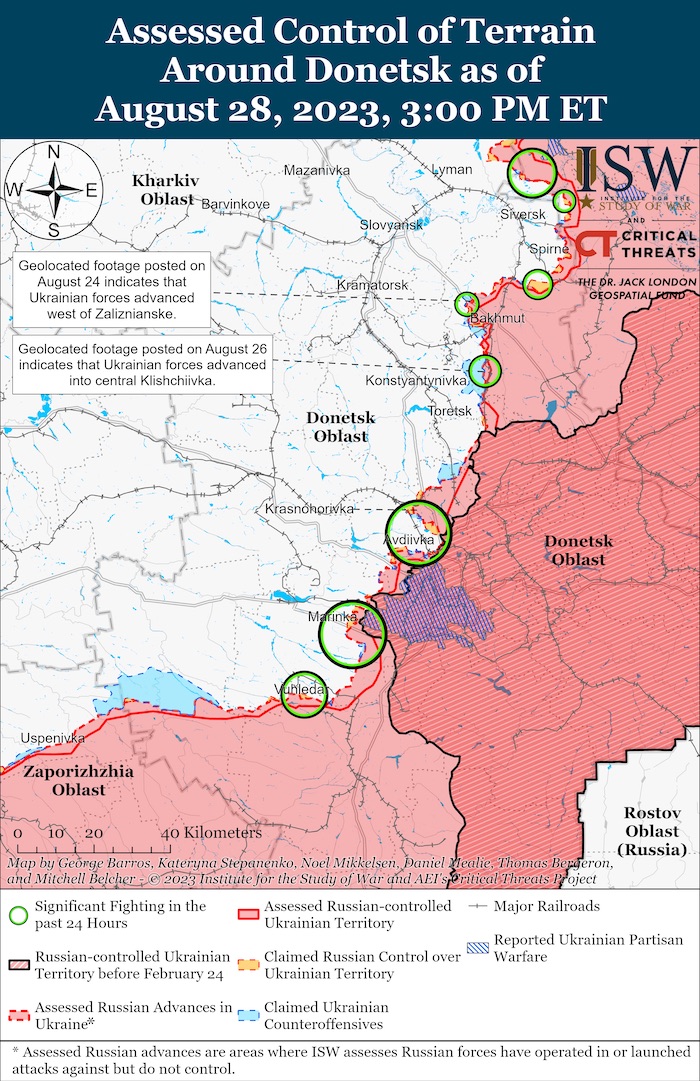
- Lyman axis: the adversary launched airstrikes in the vicinities of Novojehorivka, Tverdokhlibove, Bilohorivka (Luhansk oblast), Tors’ke, and Spirne (Donetsk oblast). More than 10 settlements, including Nevs’ke, Bilohorivka (Luhansk oblast), Verkhn’okam’yans’ke, Tors’ke, Spirne, and Rozdolivka (Donetsk oblast), were shelled with artillery.
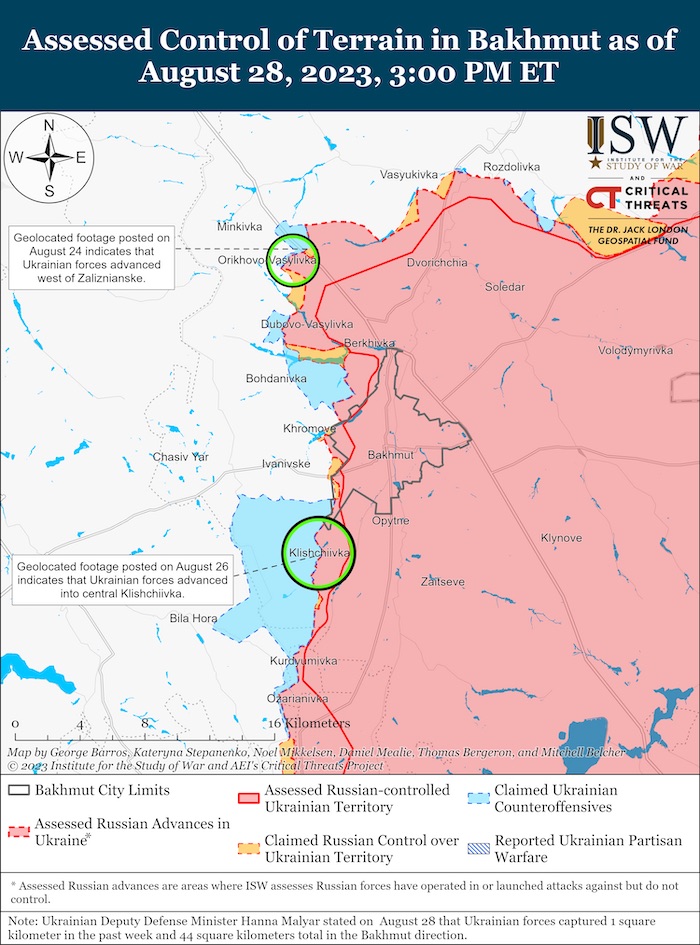
- Bakhmut axis: the adversary launched airstrikes in the vicinities of Bohdanivka, Klishchiivka, and New York (Donetsk oblast). More than 15 settlements, including Pryvillya, Hryhorivka, Ivanivske, Klishchiivka, Oleksandro-Shul’tyne, Toretsk, and Druzhba (Donetsk oblast), suffered from enemy artillery shelling.
- Avdiivka axis: the enemy launched an airstrike in the vicinity of Avdiivka, fired artillery and mortars at the settlements of Oleksandropil’, Novokalynove, Avdiivka, Sjeverne, and Pervomais’ke (Donetsk oblast).
- Marinka axis: the Ukrainian Defence Forces continue to hold back the Russian offensive in the vicinity of Marinka (Donetsk oblast). The adversary launched an airstrike in the vicinity of Krasnohorivka and Kostiantynivka (Donetsk oblast). The invaders fired artillery at the settlements of Krasnohorivka, Mar’inka, Pobjeda, Novomykhailivka, Katerynivka, and Yelyzavetivka (Donetsk oblast).
- Shakhtarske axis: the enemy launched airstrikes in the vicinities of Vodyane, Novosilka, and Blahodatne (Donetsk oblast). The enemy fired artillery at the settlements of Vuhledar, Vodyane, Maksymivka, Prechystivka, Zolota Nyva, Blahodatne, and Urozhaine (Donetsk oblast).
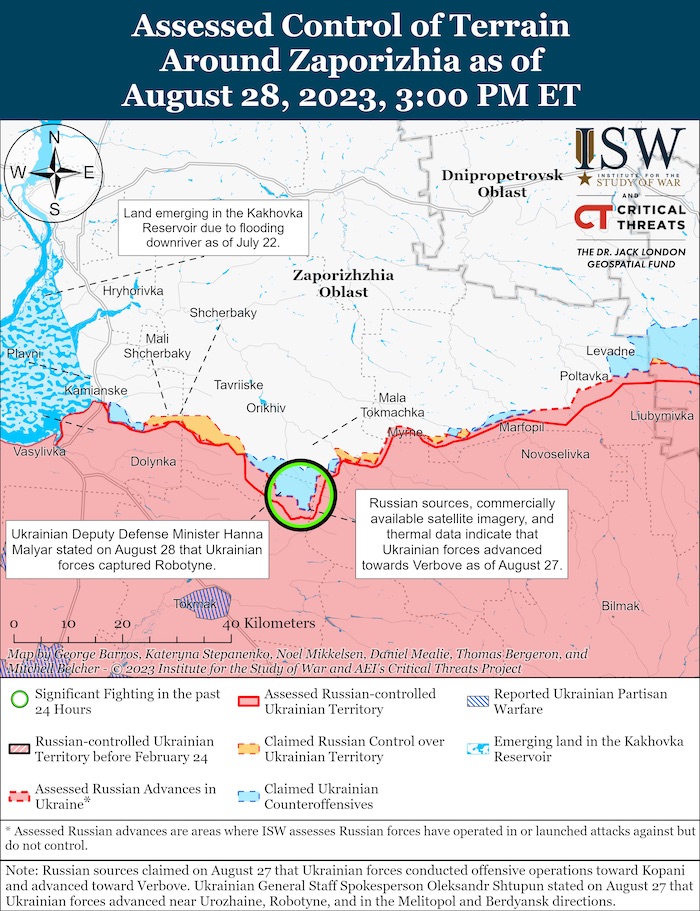
- Zaporizhzhia axis: the adversary launched airstrikes in the vicinities of Mala Tokmachka, Robotyne, and Novodanylivka (Zaporizhzhia oblast). More than 25 settlements suffered from enemy artillery shelling, including Novodarivka, Poltavka, Huliaipilske, P’yatykhatky, Charivne, Mali Shcherbaky, Kam’yans’ke, and Plavni (Zaporizhzhia oblast).
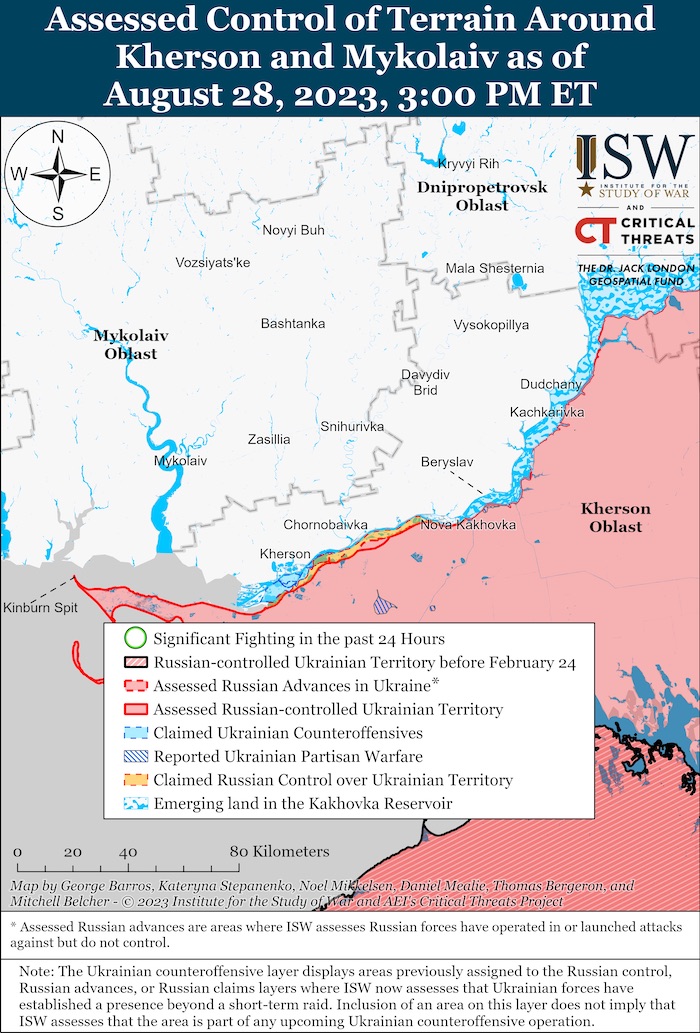
- Kherson axis: the enemy launched airstrikes in the vicinities of Mykolaivka and Ol’hivka (Kherson oblast). Kherson, Sadove, Stanislav (Kherson oblast), and Ochakiv (Mykolaiv oblast) suffered from enemy artillery shelling.
At the same time, the Ukrainian Defence Forces continue to conduct the offensive operation on the Melitopol axis, consolidating their positions and conducting counter-battery fire.
The occupiers continue to force Russian passports on the residents of the temporarily occupied territory of Kherson oblast. In the settlement of Chaplynka, the occupation administration has informed local residents of the requirement to obtain Russian passports by September 1, 2023. In case of non-compliance, the occupiers threaten to confiscate real estate. Also, the occupiers have been conducting raids since August 23, 2023, to evict people with no registration of their place of residence and to appropriate their property.
On August 28, the Ukrainian Air Force launched 8 airstrikes on the concentrations of troops, 1 airstrike on the command post, and 3 airstrikes on the anti-aircraft missile systems of the adversary.
On August 28, the Ukrainian missile and artillery troops hit 2 command posts, 1 air defence system, and 2 artillery systems of the adversary at their firing positions.“
Ukrainian military gains foothold in Robotyne, makes preparations for further actions, Ukrinform reports, citing the spokesperson for the Joint Press Center of the Defense Forces in the Tavria direction Oleksandr Shtupun. “We continue gaining a foothold in Robotyne. Stabilization measures and demining efforts are underway, as well as preparations for further actions. Over the past day, our warriors have gained some success to the southeast of this settlement, Shtupun told.
In his words, following the de-occupation of Robotyne, Ukraine can send more troops there and have better manoeuvring opportunities. Also, Robotyne is situated on the highway to Tokmak, which makes it an important logistic route. Tokmak is located around 20 kilometres away from Robotyne. Shtupun believes Russians will not leave this settlement easily, and Ukrainian forces will have to fight for it.”
About 300 Russian invaders were eliminated in Tavria direction in the past day, Ukrinform reports, citing General Oleksandr Tarnavskyi, the Commander of the Tavria Operational and Strategic Grouping of Troops. “Ukraine’s artillery units have completed 1,218 fire missions in the past 24 hours.
According to Tarnavskyi, the enemy’s losses included 293 troops and 25 military equipment units, namely one tank, four armored fighting vehicles, nine artillery systems and mortars, one anti-tank guided missile, one unmanned aerial vehicle, and nine motor vehicles. Additionally, Ukraine’s Defence Forces destroyed five Russian ammunition depots, one command post and one lookout post.”
Eastern Grouping: Russia ramps up offensive towards Lyman, Kupiansk with over 100,000 troops, The Kyiv Independent reports. “Russia has concentrated over 100,000 troops in the Kupiansk-Lyman direction of the front in Kharkiv Oblast and Luhansk Oblast, Eastern Force Grouping press officer Illia Yevlash said on Aug. 27.
These troops have significantly intensified their rate of shelling and aistrikes against Ukrainian positions, according to Yevlash. He said there are 45,000 soldiers specifically attacking towards Kupiansk and 48,000 towards Lyman.”
Enemy used about 400,000 munitions against Ukrainian troops in east over past week, Ukrinform reports. "Nearly 8,000 enemy strikes were recorded in the east over the past week. If we divide it by seven days – more than 1,000 strikes every day, Deputy Minister of Defense of Ukraine Hanna Maliar said.
Maliar noted that the enemy opened fire from artillery and attacked with aircraft shells. The enemy used nearly 400,000 munitions, that is, the fighting is very intense, she added.”
SSU military counterintelligence attacked Kursk airfield at night, Censor.net reported on 27 August. “Last night, SBU military intelligence used kamikaze drones to attack Russian military aircraft at the Kursk airfield. The 16 kamikaze drones targeted four Su-30s and one MIG-29. Among the targets hit were S-300 radars and two Pantsir missiles. Almost all SSU drones reached their targets. Only 3 of them were shot down by Russian air defence. The Russians themselves recorded 13 explosions.
The exact consequences of the damage and the number of dead and wounded will be known in the near future. The attack was organised by military counterintelligence officers from the SSU's 13th Main Directorate.
Earlier, the Russian Defence Ministry announced a night attack on Kursk and Bryansk regions. The Russians claim that air defence destroyed two drones there. Meanwhile, the Kursk region authorities reported that a drone flew into a high-rise building in the regional centre.”
Russia downs Ukrainian cruise missile over Black Sea, Reuters reports. “Russian air defences downed a Ukrainian cruise missile over the Black Sea near Crimea, Russia's defence ministry said on Monday.”
Russia said it shoots down another Ukrainian drone near Moscow, Reuters reports. “Russia said it shot down a Ukrainian drone flying towards Moscow in the early hours of Monday in an incident that once again briefly disrupted flights over the capital.
Authorities have reported more than a dozen attempted drone attacks on Moscow within the past month, a number of which have forced temporary airport closures. The drones appear to be probing Moscow's air defences from different angles, with Monday's brought down in the Lyubertsy region to the southeast of the capital, according to the defence ministry. […] Moscow reported the first drone attacks on the capital in early May, when two were fired at the Kremlin without causing damage. Since then, they have become a frequent occurrence.”
According to British Defence Intelligence, (last 48 hours):
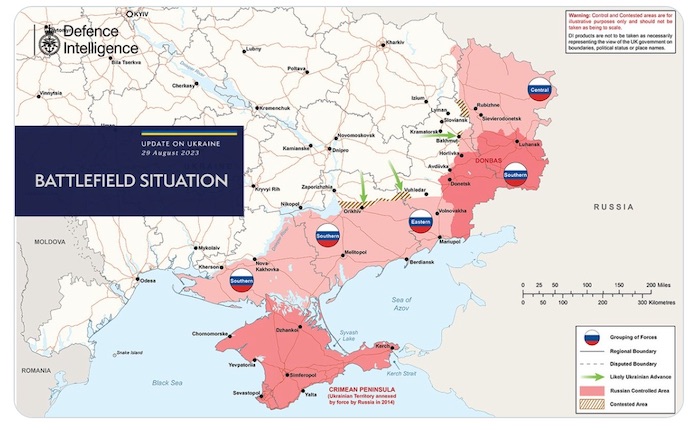
- Military service in the Russian Armed Forces has become increasingly lucrative since the invasion. On 4 February 2022 Russian President Vladimir Putin noted that a lieutenant received 81,200 rubles per month. By October 2022, he announced that even mobilised private soldiers would receive 195,000 rubles per month.
- Many junior ranks serving in Ukraine are now on over 200,000 rubles per month. This is over 2.7 times the Russian national average salary of 72,851 rubles. By way of comparison, 2.7 times the average UK salary would equate to over £90,000 a year.
- It is highly likely that the salary and additional benefits are a strong incentive for personnel to join up, especially to those from the poorer areas of Russia. However, Russia is still unlikely to meet its targets for recruiting volunteers to the ranks.
- Russia has highly likely cancelled Exercise ZAPAD (‘West’) 23, its planned ‘joint strategic exercise’ (JSE) and major annual event intended to be the culmination of the military’s training year. The exercise should have taken place in September 2023.
- From 2010 Russia ran a four-year cycle, rotating JSEs around the country. However, since 2021, Russia has based the JSE in western Russia at least every second year as it prioritises confronting what it perceives as the threat from NATO. This follows ZAPAD 21, the largest Russian exercise since Soviet times.
- The Russian military’s under-performance in Ukraine has highlighted how JSEs have had limited training value and have largely been for show. Russia has likely cancelled ZAPAD 23 because too few troops and equipment are available. There is a realistic possibility that the Russian leadership is also sensitive to domestic criticism liable from running another slickly presented JSE during wartime.
Losses of the Russian Army
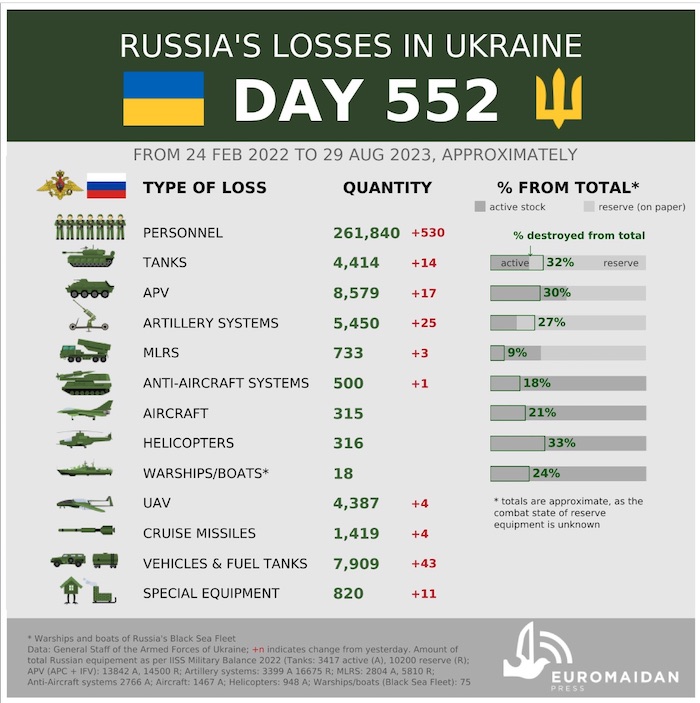
As of Tuesday 29 August, the approximate losses of weapons and military equipment of the Russian Armed Forces from the beginning of the invasion to the present day:
- Personnel – about 261840 (+530)
- Tanks – 4414 (+14)
- Armoured combat vehicles – 8579 (+17)
- Artillery systems – 5450 (+25)
- Multiple rocket launchers –MLRS - 733 (+3)
- Air defence means – 500 (+1)
- Aircraft - 315 (+0)
- Helicopters - 316 (+0)
- Automotive technology and fuel tanks – 7909 (+43)
- Vessels/boats - 18 (+0)
- UAV operational and tactical level – 4387 (+4)
- Special equipment – 820 (+11)
- Mobile SRBM system – 4 (+0)
- Cruise missiles – 1419 (+4)
Occupiers continue to prepare for mobilization of population in occupied territories of southern Ukraine, Censor.net reports, citing Center of National Resistance. “The Russian invaders created "draft boards" in the temporarily occupied territories of southern Ukraine and forced men to register for military service in fake structures.
Yes, the deployment of the "draft boards" is currently underway in the Kherson and Zaporizhzhia regions. At the same time, the Russians are already warning the male population about the need to register with fake structures, the report says.
As noted, according to preliminary data, from 2024 registration in the "draft boards" will become mandatory. The next stage will be forced mobilization, as is already happening in eastern Ukraine and Crimea. The CNR emphasizes that the mobilization of the population of the occupied territories is a violation of international law and everyone involved in the process will bear responsibility.”
At least 585 missiles remain in Russia, Censor.net reports, citing RBC-Ukraine quoting the deputy head of the Defence Intelligence, Vadym Skibitsky. “The Russian invaders have at least 585 missiles with which they can attack the territory of Ukraine. This is without taking into account the Kh-22 missiles. According to him, the General Directorate of Intelligence very carefully monitors everything related to the enemy's stockpiles of missiles and their production.
If we talk about Iskander ballistic and cruise missiles, then, according to our data, there are currently about 270 of them. The reserves of Kalibr are approximately 140 missiles. They have fewer Kh-101s, while the total number of Kh-101s, Kh-555s, and Kh-55s with a warhead, according to our calculations, there are about 100 missiles, Skibitsky explained. Also, according to him, the Russians may have about 75 Kindzal missiles in stock.
He added that the Russians are now using the Kh-101 less than last fall. There are two reasons for this. First, they are forced to take into account the critical limit, that is, to save stocks of these missiles. After all, according to the plans, the Russians can produce about 40 Kh-101 missiles every month, but we already clearly know that these plans are not being fulfilled. This is primarily due to the shortage of foreign components. The second factor is that Russia is trying to accumulate stocks of these missiles, which are considered more accurate and effective, if compared, for example, to the Kh-555, Kh-22, or even Kalibr cruise missiles, which we successfully shoot down, Skibitsky concluded.”
Humanitarian
Invaders have killed about 100,000 people in Mariupol – human rights defenders, Ukrinform reports. “The Russian invaders have killed approximately 100,000 civilians in Mariupol, and this is a confirmed number. Mykhailo Romanov, an expert at the Kharkiv Human Rights Protection Group, said this during the presentation of a legally substantiated submission to the International Criminal Court about the genocide of people in Mariupol by the Russian invaders at the Ukrinform press center. […]
He noted that people in Mariupol were killed in different ways, methods, with the use of different weapons, but, in any case, those were murders. […] The working group, which consisted of the Kharkiv Human Rights Protection Group team and Mariupol citizens who had left, together collected information about the crimes of the Russians and wrote a corresponding submission. This large submission, available in Ukrainian and English, contains a lot of information about Mariupol, about how adults and children were killed there. It will be published and sent to the International Criminal Court.”
Invaders have taken more than 1,000 children from Mariupol to Russia – human rights defender, Ukrinform reports. “The Russian invaders have taken more than 1,000 Ukrainian children from the captured Mariupol to the Russian Federation, and this is not the final figure. Mykola Komarovskyi, a lawyer of the Kharkiv Human Rights Protection Group, said this during the presentation of a legally substantiated submission to the International Criminal Court about the genocide of people in Mariupol by the Russian invaders at the Ukrinform press center. […]
As for actual data, he added, there are known cases of children being taken from the city of Mariupol to sports and recreation resorts and camps in Russia. "It is known that the children were studying directly in camps so as not to interrupt the educational process. But, as we can guess, this process adhered to the Russian system. Children are taught the Russian version of history; they were told about the events taking place in Ukraine from the point of view of the Russian Federation. That is, children, who lived in Ukraine and studied in their native language, got into a completely different environment, where their native language is clearly perceived as hostile, the lawyer said.”
Mandatory evacuation of children to be introduced in two districts of Zaporizhzhia region, Ukrinform reports, citing Deputy Prime Minister - Minister for Reintegration of the Temporarily Occupied Territories Iryna Vereshchuk. “On Monday, August 28, the authorities will announce the mandatory evacuation of children from Vasylivka and Polohy districts of Zaporizhzhia region. We will have an evacuation headquarters meeting today, the mandatory evacuation of children from two districts of Zaporizhzhia region - Vasylivka and Polohy districts - will be announced. Five settlements, we have to evacuate 54 children," said Vereshchuk.
According to her, the mandatory evacuation of children is underway in Vovchansk community of Kupiansk district, Kharkiv region. In addition, 89 children remain in Donetsk region and need to be taken to safer places. […]
As reported, mandatory evacuation region has been carried out from Donetsk region since August 2022. Thus, more than 87,000 citizens moved to safer regions over the year. Among them are more than 10,700 children and more than 3,700 people with reduced mobility. Mandatory evacuation of the civilian population from frontline settlements in the Kupiansk sector continues in Kharkiv region.”
Legal
Ukrainian defender sentenced to 20 years' imprisonment by Russian occupiers, Ukrainska Pravda reports, citing Investigative Committee of Russia. “Russian occupiers from the so-called "LNR" (Luhansk People's Republic) have sentenced Serhii Boichuk, a serviceman from the 10th Separate Mountain Assault Brigade of the Ukrainian Armed Forces, to 20 years in prison.
Boichuk is a mechanic and driver with the 108th Separate Mountain Assault Battalion (military unit A3715) of the 10th Separate Mountain Assault Brigade (military unit A4267) of the Armed Forces of Ukraine. He has been convicted of allegedly "shelling residential buildings in the Popasna district" in the occupied part of Luhansk Oblast. The Ukrainian defender has been sentenced to 20 years in a maximum-security penal colony.”
In Vinnytsia, more than 10 officials of military medical commission and doctors who helped evaders to go abroad were exposed, Censor.net reports, citing the Security Service of Ukraine. “The SSU jointly with the National Police in Vinnytsia eliminated a large-scale scheme of illegal departure of citizens of military age abroad. […] As a result of complex measures, the organiser of the fraud, an official of a local medical diagnostic centre, who involved more than 10 people in illegal activities, was detained. First of all, officials of the regional military medical commission.
In exchange for money, the organiser of the scheme offered potential conscripts to avoid mobilisation and flee abroad based on fictitious documents on their medical fitness for military service. He estimated the cost of such "services" at between USD 3,000 and USD 10,000. The amount depended on the "complexity" of the diagnosis and the urgency of its "establishment"," the report says.
As noted, after receiving the order, the offender turned to his accomplices from the local military medical commission, who falsified medical reports on the health status of their clients. In this way, they created a formal basis for "writing off" the evaders from the military register and lifting the relevant restrictions on travelling abroad.
The SSU officers established more than 200 episodes of committing a crime by the organiser of the scheme and his accomplices. Law enforcement officers detained the main suspect, an official of a medical diagnostic centre, red-handed while he was transferring a new amount of bribe money. […]
He has been served a notice of suspicion under Part 3 Article 332 of the Criminal Code of Ukraine (illegal transfer of persons across the state border of Ukraine). In addition, the issue of additional qualification of the criminal actions under Part 2 Art. 368 of the Criminal Code of Ukraine is being decided. The offenders face up to 10 years in prison with confiscation of property.”
Ukraine's Defence Ministry pays billions of hryvnias to Polish firm Alfa but receives no weapons, Ukrainska Pravda reports. “The Ukrainian Ministry of Defence (MoD) entered into a series of contracts with the Polish company Alfa in 2022 for the supply of various types of weapons and ammunition. However, the company failed to fulfil its obligations and, as of 2023, owed the Ukrainian MoD over UAH 3.5 billion (roughly US$94,77 million).
Ukrainska Pravda reported that the Ukrainian MoD has entered into several agreements with the Polish company Alfa since April 2022. The Polish company was obliged to supply the Ukrainian MoD with the flak jackets and helmets but failed to do so on time and did not fulfil the order by 100%.
Meanwhile, the Ukrainian MoD concluded a range of other unfavourable agreements with Alfa, and as of early 2023, the company owed the Ukrainian Defence Ministry over US$94,77 million under various contracts. The Polish firm received and withdrew billions of hryvnias from Ukraine. However, it failed to deliver the paid-for weapons. UP is aware of at least 7 agreements concluded by the Ukrainian MoD directly with Alfa. Some of them are being disputed in international arbitration. […]
Polish Alfa was founded as a limited liability company back in 2005. The company is engaged in selling various products, including military ones. The company reported a profit of PLN 1.23 million (slightly more than €300,000) in 2020, and Alfa earned PLN 7.4 million (about €1.8 million) in 2021.
Alfa has not yet submitted its financial statements for 2022 when the company signed contracts worth hundreds of millions in Ukraine. On the contrary, the company has amended its data in the registers 4 times in the first half of 2023, which may be a way to delay the submission of reports.”
Zelenskyy says he wants elections in 2024: billions and observers in trenches needed, Ukrainska Pravda reports. “Commenting on US Republican Senator Lindsey Graham’s position that elections in Ukraine should be held in 2024 despite the war, Zelenskyy said that he spoke with Graham personally. The president admitted that the issue of elections in Ukraine could split the support of the United States of America, and the argument put forward is that the US held elections even during the war. However, he gave a reminder that holding elections during wartime is prohibited by law in Ukraine.
The logic is that if you are protecting democracy, then you have to think about this protection even during times of war. Elections are one of the protections. But there is a reason why elections are prohibited by law during wartime – it is very difficult to hold them. […] Assuming our parliamentarians are ready, then we need changes to the legislation, to the Electoral Code, to do it quickly – this is step number one.
Let’s assume, I told him, you are ready to give me 5 billion, because I can't just take 5 billion from the budget, as it seems to me that this is the amount needed to hold elections in normal times, and in wartime, I don't know what the amount would be – if the United States of America together with Europe gives us financial support [then Ukraine will hold elections – ed.]. […]
I will not hold elections on credit. I will not take money from [what we’re spending on - ed.] weapons and allocate it to elections, either. This is provided for by law. But if you give me this financial support and if the parliamentarians understand that we need to do this, then let's change the legislation quickly... And most importantly, let's take risks together. But how? Observers must be in the trenches. I told him: you and I must send observers to the front line so that we have legitimate elections for ourselves and the whole world. And that's absolutely fair. […]
The President added that the West, primarily Europe, will have to open the opportunity for 7 million Ukrainian refugees to vote because Ukraine does not have such infrastructure capabilities. And refugees should not be deprived of the right to vote. Zelesnkyy says that no one has yet shown him how to organise elections for military personnel on the front lines and for refugees abroad.”
Support
Greece Might Send Leopard 1 Tanks to Ukraine, European Pravda reports. “Germany has approached Greece with an offer to send 100 currently in use Greek Leopard 1A5 tanks to Ukraine, receiving in return upgraded armoured vehicles. As reported by the Greek media Flight, in exchange for the old Leopard 1A5 tanks, Greece could receive upgraded tanks from Italian stocks on a one-to-one basis. In this arrangement, Germany would cover the costs of a complete overhaul on Greek facilities or any other location chosen by the Greek government.
Additionally, these armoured vehicles would be equipped with modern thermal imagers, also used in Leopard 2 tanks. The tanks would also receive additional armour. The only requirement from Germany is to provide functional tanks, as Greek Leopard 1A5 tanks have not been updated in any way for more than three decades.
The tank exchange could take place based on a three-way agreement. Ukraine could receive Greek BMP-1 vehicles in exchange for Germany providing Greek Marder 1 armoured vehicles. Earlier, media reported that the Greek government decided to terminate the contract with Russia for maintaining the Tor-M1 and Osa-AKM air defence missile systems in service with the country's army. It is speculated that these systems might be sent to Ukraine in the future.”
Ukraine can start using F-16 fighter jets in spring of next year, Censor.net reports, citing an interview of the Minister of Defense of Ukraine Oleksii Reznikov in Bild. “I would say that this (the appearance of the F-16 at the front - ed.) can happen in the spring of next year because we have started training courses for our pilots, engineers, and technicians, the minister said. According to him, it is necessary to prepare the infrastructure for the use of aircraft in Ukraine. It should take at least six months, and maybe a little more, added Reznikov.
As the head of the Ministry of Defense of Ukraine noted, the appearance of fighter jets at the front can change the rules of the game in the war. We must put an end to Russia's dominance in the skies, off the battlefield. F-16s will become part of air defence. We can strengthen our capabilities in the sky to protect the airspace, that is, our cities. It would be a big breakthrough for us. Very big, Reznikov stressed. […] The Air Force said that Ukraine needs 128 fighter jets to gain air superiority.”
Ukrainian Intelligence receives info about events in Crimea from satellite, says intelligence chief, Ukrainska Pravda reports, citing Krym.Realii. “Ukrainian intelligence can monitor the Russian army in Crimea via satellite, Kyrylo Budanov, Chief of Ukraine’s Defence Intelligence, has said. Budanov said information from the satellite reaches Ukrainian intelligence with an hour's delay.
We have no problems with space intelligence. There are problems with the speed at which the information is obtained. This is a technical process. Yes, I’d like it to be like it is in the movies, so that you could look somewhere and [tell people:] ‘go left or right’. Few countries in the world can afford that. Unfortunately, we can’t do this yet. But seeing what’s happening now is not a problem for us."
New developments
- Moldova's President Calls for More Support for Ukraine: Russia Won't Stop, European Pravda reports. “President of Moldova, Maia Sandu, has underlined the necessity of providing more support to Ukraine to halt Russia. Ukraine needs to get more support… and everybody should understand that if Ukraine is not helped, then Russia will not stop in Ukraine or Moldova, Sandu pointed out in an interview with CNN. She hopes that, more support will be coming soon, so that Ukraine could recover its territories and we will see an end to this crazy war."
- Lithuania plans to close two more checkpoints on the border with Belarus, Ukrainska Pravda reports, citing Agnė Bilotaitė, the Lithuanian Minister of Internal Affair, as reported by LRT. "The Ministry of Internal Affairs has advised closing two more checkpoints. These are the border crossings at Lavoriškės and Raigardas", – the Minister stated. She stated that the decision to close two more checkpoints was made in order to decrease the scale of smuggling at the border and transfer the border guards to other border checkpoints. Earlier, Lithuania announced the temporary closure of two out of six checkpoints at the border with Belarus, starting from 18 August. The checkpoints near the villages of Shumskas and Tverečius have been closed since then. Following a meeting of the Internal Ministers of Poland, Latvia, Lithuania and Estonia on 28 August, it was agreed that the border with Belarus will be completely closed in the case of a "critical incident".
- Erdoğan's party confirms his visit to Putin, Ukrainska Pravda reports, citing Daily Sabah, quoting Ömer Çelik, spokesperson for the Justice and Development Party. “Recep Tayyip Erdoğan, President of Türkiye, will visit Russia and meet with Vladimir Putin next week, the Turkish pro-government Justice and Development Party has confirmed. President Erdoğan has so far led an intense diplomacy in order to help prevent a global food crisis, Çelik said. Çelik said the meeting between Putin and Erdoğan will take place in Sochi. Politicians believe Erdoğan’s visit could mean progress with regard to Russia's return to the Black Sea Grain Initiative.”
- Kuleba calls on neighbors not to hold Ukrainian grain export hostage to domestic politics, Ukrinform reports. “Ukraine will fight to ensure that there are no restrictions on the export of its grain to the EU. Minister of Foreign Affairs of Ukraine Dmytro Kuleba said this during a press conference with his Czech counterpart Jan Lipavský in Prague on Monday, an Ukrinform correspondent reports. The Minister reminded: the restrictions are expected to be lifted on September 15, their validity period will end. However, the voices of a group of neighboring countries are being heard: if it comes to that, they will introduce their own national restrictions. We are absolutely and categorically against this, the Ukrainian politician emphasized. He explained that such a step would violate the principles of the internal market, it would contradict the EU-Ukraine Association Agreement and, above all, this step was against the principle of EU solidarity on which this organization is based. Kuleba called on the relevant countries not to hold the issue of grain export hostage to the processes of their domestic politics."
Assessment
- On the War
The Institute for the Study of War has made the following assessment as of Monday 28 August:
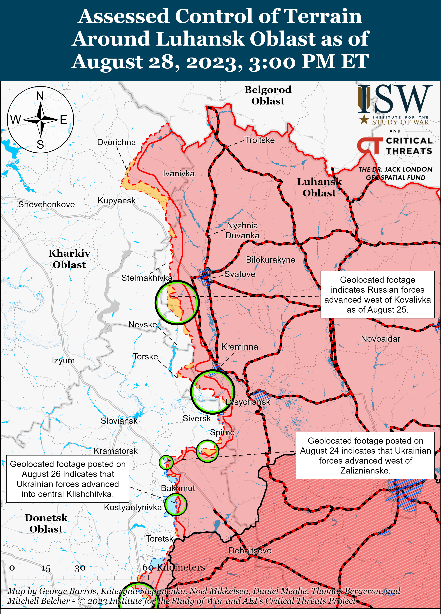 (quote) “Russian forces attacked Ukrainian positions on the Kupiansk-Svatove line on August 28, and reportedly made limited localized advances on the frontline. A Russian milblogger claimed that Russian forces seized two Ukrainian positions in the Synkivka-Petropavlivka area (9km northeast and 6km east of Kupiansk, respectively). A Russian news aggregator claimed that Russian forces are continuing to clear positions near Synkivka and Petropavlivka, and are advancing in the Kupiansk direction. The Russian Ministry of Defense (MoD) similarly claimed that elements of the Russian Western Grouping of Forces seized an unspecified Ukrainian position in the Kupiansk direction. A Kremlin-affiliated milblogger claimed that Russian forces are exerting pressure on Ukrainian forces near Synkivka and Petropavlivka, but observed that Russian forces are unlikely to break through Ukrainian defenses in the near term. The milblogger added that swampy terrain and continuous minefields in the Kupiansk direction create serious problems for Russian advances in this area. Ukrainian Deputy Defense Minister Hanna Maliar reported that Russian forces are mining positions along Belgorod Oblast’s border with Ukraine and are continuing to look for weak spots in Ukrainian defenses. Ukrainian Eastern Group of Forces Spokesperson Ilya Yevlash stated that 45,000 Russian personnel are currently operating in the Kupiansk direction.
(quote) “Russian forces attacked Ukrainian positions on the Kupiansk-Svatove line on August 28, and reportedly made limited localized advances on the frontline. A Russian milblogger claimed that Russian forces seized two Ukrainian positions in the Synkivka-Petropavlivka area (9km northeast and 6km east of Kupiansk, respectively). A Russian news aggregator claimed that Russian forces are continuing to clear positions near Synkivka and Petropavlivka, and are advancing in the Kupiansk direction. The Russian Ministry of Defense (MoD) similarly claimed that elements of the Russian Western Grouping of Forces seized an unspecified Ukrainian position in the Kupiansk direction. A Kremlin-affiliated milblogger claimed that Russian forces are exerting pressure on Ukrainian forces near Synkivka and Petropavlivka, but observed that Russian forces are unlikely to break through Ukrainian defenses in the near term. The milblogger added that swampy terrain and continuous minefields in the Kupiansk direction create serious problems for Russian advances in this area. Ukrainian Deputy Defense Minister Hanna Maliar reported that Russian forces are mining positions along Belgorod Oblast’s border with Ukraine and are continuing to look for weak spots in Ukrainian defenses. Ukrainian Eastern Group of Forces Spokesperson Ilya Yevlash stated that 45,000 Russian personnel are currently operating in the Kupiansk direction.
Russian forces continued to concentrate their offensive efforts on the Svatove-Kreminna line on August 28 but did not make any advances. The Ukrainian General Staff reported that Ukrainian forces repelled a Russian attack on Novoyehorivka (15km southwest of Svatove). Maliar noted that Russian forces are continuing unsuccessful offensive operations southwest of Kreminna, near Bilohorivka (13km south of Kremina), in the Serebryanske forest area (south of Kreminna), and near Vesele (31km southwest of Kreminna). Russian sources also claimed that Russian forces attacked near Bilohorivka, Novoyehorivka, and the Serebryanske forest area – with one Kremlin-affiliated milblogger specifying that Russian forces did not advance near Novoyehorivka. The Kremlin-affiliated milblogger claimed that Russian forces are attacking Novoyehorivka and Bilohorivka to sever Ukrainian ground lines of communication (GLOCs) in Borova (35km west of Svatove) and Siversk (18km southwest of Kreminna), respectively. Maliar stated that Russian forces are preparing to regroup forces in the Lyman direction (west of Kreminna) and are trying to use the most professional Russian Airborne (VDV) Assault units on the Luhansk Oblast frontline in order to draw Ukrainian forces from the Bakhmut direction. Yevlash stated that 48,000 Russian personnel are currently operating in the Lyman direction, and Russian milbloggers reiterated Yevlash’s report noting that there are 110,000 Russian troops along the entire Kupiansk-Svatove-Kreminna frontline. A Kremlin-affiliated milblogger also indicated that elements of the BARS-12 (Russian Combat Reserve) unit are operating south of Kreminna in the Siversk salient.
Russian sources claimed that Ukrainian forces continued counterattacks on the Kupiansk-Svatove-Kreminna line on August 28, but did not regain new territory. The Russian MoD claimed that Russian forces repelled Ukrainian attacks near Synkivka, Novoselivske (15km northwest of Svatove), and Kuzmyne (less than 3km southwest of Kreminna).
Ukrainian forces conducted offensive operations near Bakhmut and advanced on August 28. Maliar reported that Ukrainian forces pushed Russian forces out of positions east of Klishchiivka (7km southwest of Bakhmut) and in the center of the settlement and are continuing to advance along Bakhmut’s southern flank. Maliar also reported that Ukrainian forces are making unspecified progress near Orikhovo-Vasylivka (11km northwest of Bakhmut). Maliar reported that Ukrainian forces have liberated a total of 44 square kilometers in the Bakhmut direction, including 1 square kilometer in the last week. Russian sources, including the Russian Ministry of Defense (MoD), claimed that Ukrainian forces unsuccessfully attacked near Klishchiivka. A Russian milblogger claimed on August 27 that Ukrainian forces unsuccessfully attacked near Kurdyumivka (13km southwest of Bakhmut), Andriivka (10km southwest of Bakhmut), and Klishchiivka.
Russian forces conducted offensive operations near Bakhmut on August 28 and reportedly advanced. The Ukrainian General Staff reported that Russian forces conducted unsuccessful offensive operations near Klishchiivka. Ukrainian Deputy Defense Minister Hanna Maliar reported that Russian forces unsuccessfully attempted to restore lost positions near Orikhovo-Vasylivka and Klishchiivka. A Russian milblogger claimed on August 27 that Russian forces made unspecified gains near Berkhivka (6km northwest of Bakhmut) over the past week. Russian sources claimed on August 27 and 28 that Russian forces counterattacked near Klishchiivka and conducted offensive operations near Orikhovo-Vasylivka. A Russian source claimed that Russian forces attacked near Dubovo-Vasylivka (6km northwest of Bakhmut) and Ivanivske (6km west of Bakhmut). Ukrainian Eastern Group of Forces Spokesperson Ilya Yevlash reported that Russian forces are trying to restore lost positions in the Bakhmut direction, especially on the southern flank. Yevlash stated that Russian forces are committing reserves without proper training to the Bakhmut area. Yevlash added that Russian forces first commit convict personnel from various unspecified private military companies (PMCs) to conduct assaults without artillery support or heavy equipment, followed by better trained personnel with protection.
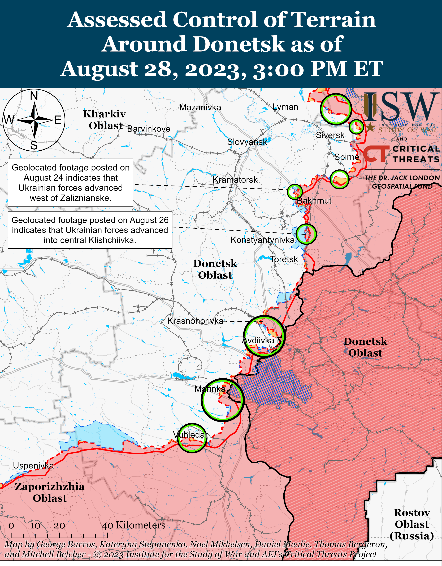 The Russian MoD claimed that Ukrainian forces unsuccessfully attacked along the Avdiivka-Donetsk City line near Krasnohorivka (either 8km northwest of Avdiivka or directly west of Donetsk City).
The Russian MoD claimed that Ukrainian forces unsuccessfully attacked along the Avdiivka-Donetsk City line near Krasnohorivka (either 8km northwest of Avdiivka or directly west of Donetsk City).
Russian forces conducted offensive operations along the Avdiivka-Donetsk City line but did not make any claimed or confirmed gains on August 28. The Ukrainian General Staff reported that Russian forces unsuccessfully attacked near Marinka (directly west of Donetsk City). Maliar reported that Russian forces conducted unsuccessful offensive operations near Stepove (8km northwest of Avdiivka), Avdiivka, Marinka, and Novomykhailivka (10km southwest of Donetsk City). Russian milbloggers claimed that Russian forces attacked in Marinka and near Stepove. A Russian milblogger claimed on August 27 that Russian forces are periodically attacking near Novomykhailivka and Avdiivka, but not nearly as intensely as a few months ago.
Geolocated footage published on August 27 indicates that Ukrainian forces recently made marginal gains north of Shevchenko (40km southwest of Donetsk City) in western Donetsk Oblast.
Ukrainian Deputy Defense Minister Hanna Maliar reported on August 28 that Russian forces conducted unsuccessful offensive operations near Vuhledar (30km southwest of Donetsk City) in western Donetsk Oblast.
Russian sources claimed that Ukrainian forces continued limited unsuccessful offensive operations along the administrative border between Donetsk and Zaporizhzhia oblasts on August 28. The Russian MoD claimed that elements of the Russian Eastern Grouping of Forces repelled two Ukrainian assaults near Staromayorske (9km south of Velyka Novosilka). Russian milbloggers claimed that the tempo of Ukrainian offensive operations in the Donetsk-Zaporizhzhia Oblast border area continues to decline. A Russian milblogger claimed that Ukrainian forces unsuccessfully attempted to advance towards Pryyutne (15km southwest of Velyka Novosilka), Staromlynivka (14km south of Velyka Novosilka), and Kermenchyk (15km southeast of Velyka Novosilka) in the past week. The milblogger expressed concern about the possibility of Ukrainian forces capturing positions near Kermenchyk, which he claimed serve an important role in the Russian defensive layer in the area. […]
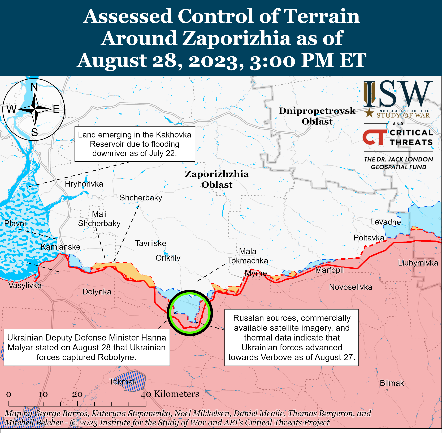 Maliar announced on August 28 that Ukrainian forces have liberated Robotyne (10km south of Orikhiv) in western Zaporizhzhia Oblast. […] Russian sources denied Maliar’s announcement and continue to claim that Russian forces maintain positions on the southern outskirts of Robotyne. Russian milbloggers claimed that fighting continues in Robotyne itself and in the surrounding areas.
Maliar announced on August 28 that Ukrainian forces have liberated Robotyne (10km south of Orikhiv) in western Zaporizhzhia Oblast. […] Russian sources denied Maliar’s announcement and continue to claim that Russian forces maintain positions on the southern outskirts of Robotyne. Russian milbloggers claimed that fighting continues in Robotyne itself and in the surrounding areas.
Ukrainian forces continued offensive operations in western Zaporizhzhia Oblast on August 28 and likely made further advances. Maliar reported that Ukrainian forces achieved unspecified success in the direction southeast of Robotyne and south of Mala Tokmachka (7km southeast of Orikhiv) and are advancing in the direction of Novodanylivka (4km south of Orikhiv), Novopokropivka (15km south of Orikhiv), Mala Tokmachka, and Ocheretuvate (25km southwest of Orikhiv). Russian milbloggers claimed that Ukrainian forces advanced in the direction of Verbove (18km southwest of Orikhiv), with one milblogger claiming that the frontline is less than four kilometers away from the settlement in an unspecified area west of Verbove. NASA’s FIRMS/VIIRs sensors show a large number of heat anomalies next to a segment of Russian anti-tank trenches to the west of Verbove on August 27, suggesting that Ukrainian forces may be attempting to breach the Russian defensive positions there. The heat anomalies and Russian reports of Ukrainian advances likely indicate that Russian forces do not control territory west of this segment of anti-tank ditches. A Russian milblogger expressed concern about the vulnerability of Russian positions along the Robotyne-Verbove line in the event of further Ukrainian advances through Russian defensive positions near Verbove. A prominent Russian milblogger claimed that reports of Ukrainian breakthroughs closer to Novoprokopivka are false.
The Russian MoD and Crimean occupation head Sergei Aksyonov claimed on August 28 that Russian air defense shot down two Ukrainian drones over Crimea. The Russian MoD and other Russian sources also claimed that Russian air defense shot down a Ukrainian cruise missile off the coast of Crimea.
Ukrainian officials formally acknowledged that Ukrainian forces had liberated Robotyne amid continued Ukrainian advances in western Zaporizhzhia Oblast and near Bakhmut. Ukrainian Deputy Defense Minister Hanna Maliar reported on August 28 that Ukrainian forces have liberated Robotyne, achieved unspecified successes southeast of Robotyne (10km south of Orikhiv) and south of Mala Tokmachka (7km southeast of Orikhiv), and are advancing in the directions of Novodanylivka (4km south of Orikhiv), Novopokropivka (15km south of Orikhiv), Mala Tokmachka, and Ocheretuvate (25km southwest of Orikhiv). Heat anomalies from NASA FIRMS/VIIRS sensors and Russian claims of Ukrainian advances likely indicate that Ukrainian forces advanced near Verbove. Maliar also stated that Ukrainian forces pushed Russian forces out of positions east of Klishchiivka (7km southwest of Bakhmut) and in the center of the settlement and have made unspecified progress near Orikhovo-Vasylivka (11km northwest of Bakhmut).
Maliar reported that Ukrainian forces continue offensive operations in the southern direction, which she specified is the main direction of Ukrainian offensive operations. Maliar’s statement is consistent with the scale of Ukrainian offensive operations that ISW has observed in southern and eastern Ukraine. Ukrainian forces are currently conducting two operational efforts in southern Ukraine in western Zaporizhzhia Oblast and in the Donetsk-Zaporizhzhia Oblast border area, and Maliar did not indicate one effort as the main offensive direction.
The Russian military command continues to expend relatively elite Russian airborne forces by deploying these troops to defend vulnerable positions against Ukrainian counteroffensives. Geolocated footage published on August 27 indicates that the Russian military command deployed elements of the Russian 76th Guards Air Assault (VDV) Division to reinforce Russian positions near Robotyne likely from the Kreminna area in Luhansk Oblast. ISW had previously observed that elements of almost all Russian VDV formations are operating in areas where Ukrainian forces are conducting counter-offensive operations, and this lateral redeployment further suggests that Russian forces may be using relatively elite units to reinforce critical sectors of the frontline. Russian forces previously redeployed the 7th Guards Mountain VDV Division from Kherson Oblast to support Russian defenses in eastern and western Zaporizhzhia Oblast and have transferred other VDV forces from Luhansk Oblast to defend against Ukrainian counteroffensives on Bakhmut’s flanks. The Russian military command has consistently relied on VDV formations as both an offensive and a defensive force and they are likely degraded from their high operational tempo. The degradation of these forces will likely weaken Russia’s ability to sustain complex defensive operations and almost certainly disrupt any Russian intent to resume offensive operations at scale, which have predominantly relied on relatively elite infantry that Russia now lacks.
Russian forces conducted a missile strike on the rear areas of Ukraine on August 28. Ukrainian officials reported that Russian forces launched four Kalibr cruise missiles from the Black Sea and two Kh-59 cruise missiles from the airspace above occupied Kherson Oblast in the direction of Kryvyi Rih on the night of August 28 and that Ukrainian air defenses intercepted all but two Kalibr missiles. The Ukrainian Air Force reported that the Russian missiles struck a civilian industrial facility in Poltava Oblast. […]
Ukrainian officials stated that Russian forces may intend to resume a wider campaign against Ukrainian critical infrastructure in the fall of 2023, but assessed Russia likely has not replenished its missile stocks to sustain a campaign on the scale of the winter 2022-2023 strikes. Skibitskyi stated that Russian forces are conducting reconnaissance on Ukrainian infrastructure facilities and may begin a massive strike series with missiles and drones at the end of September or in October. Russian forces conducted strikes with up to 100 missiles in a single strike series during the air campaign in the fall and winter of 2022, and the marginal replenishment of their missile stocks will likely prevent them from conducting an air campaign at anywhere near that scale. Ukrainian Air Force Spokesperson Colonel Yuriy Ihnat stated that Russia is increasing its missile production but not enough to maintain the same intensity of strikes as the fall and winter of 2022.
Ukrainian officials assessed that any upcoming Russian strike campaign may employ new tactics that use fewer missiles and more drones. Skibitskyi stated that Russian forces are improving their targeting and decision-making speed, are more carefully selecting targets, and are meticulously searching for flight routes that can bypass Ukrainian air defense systems. ISW has previously reported on Russian forces’ ability to innovate and learn over the course of the war. Skibitskyi stated that possible upcoming large-scale Russian strikes may use only about 10 to 30 missiles but will be accompanied by a much larger number of Iranian Shahed-131/136 drones. Skibitskyi and Ihnat stated that a larger number of drones would allow Russian forces to further bypass Ukrainian air defenses, allowing other projectiles to reach their targets. Ihnat stated that drones will likely be used in strikes on Ukrainian energy infrastructure, and Skibitskyi noted that Russian forces have previously used Shahed drones to widely damage Ukrainian electrical substations. Russia has reportedly begun domestically producing modified versions of Shahed-131/136 drones but is reportedly struggling to produce them at the pace and quality it desires. ISW previously assessed that the Russian command may believe that a large number of strike drones will allow Russian forces to overwhelm Ukrainian air defenses, although Shahed drones remain Russia’s high precision weapon system most vulnerable to Ukrainian air defenses. […]
Russian milbloggers continued to criticize the Russian Ministry of Defense (MoD) for ignoring ultranationalists’ complaints over the mistreatment of a Southern Military District (SMD) brigade operating in the Kherson direction. Russian milbloggers continued to claim that the Russian military command chose to ignore and silence reports about elements of the 205th Separate Motorized Rifle Brigade (49th Combined Arms Army, Southern Military District) suffering significant losses with inadequate artillery support and poor leadership in the Kherson direction. One milblogger claimed that the Russian MoD continues to face bureaucratic problems that prevent the Russian military from ingesting criticism and undergoing reforms. The milblogger claimed that Russian ultranationalists were hopeful that the Russian military command would improve its management of the war effort after Wagner Group financier Yevgeny Prigozhin’s armed rebellion that sought to change Russia’s military command – but such hopes did not materialize. The milblogger claimed that the outrage over the treatment of the 205th Separate Motorized Rifle Brigade divided the Russian information space into milbloggers who are loyal to the Russian MoD and those who oppose the Russian MoD. Another milblogger claimed that he refrains from sharing 90 percent of his information on Russian military failures, noting that Russian officials perceive the limited amount of criticism as a personal attack on them instead of thinking on how to improve conditions for Russian servicemen.
Key Takeaways:
- Ukrainian officials formally acknowledged that Ukrainian forces liberated Robotyne amid continued Ukrainian advances in western Zaporizhzhia Oblast and near Bakhmut.
- The Russian military command continues to expend relatively elite Russian airborne forces by deploying these troops to defend vulnerable positions against Ukrainian counteroffensives.
- A Ukrainian intelligence official indicated that Russian forces may have marginally replenished their stocks of high-precision missiles through conservation in the summer of 2023.
- Ukrainian officials stated that Russian forces may intend to resume a wider campaign against Ukrainian critical infrastructure in the fall of 2023, but assessed Russia likely has not replenished its missile stocks to sustain a campaign on the scale of the winter 2022-2023 strikes.
- Ukrainian officials assessed that any upcoming Russian strike campaign may employ new tactics that use fewer missiles and more drones.
- Russian milbloggers continued to criticize the Russian Ministry of Defense (MoD) for ignoring ultranationalists’ complaints over the mistreatment of a Southern Military District (SMD) brigade operating in the Kherson direction.
- Russian forces conducted offensive operations on the Kupiansk-Svatove-Kreminna line, near Bakhmut, along the Avdiivka-Donetsk City line, and in western Donetsk, and did not make any confirmed advances.
- Russian lawmakers and the Russian information space expressed varied opinions about a proposed Russian State Duma bill that would deprive individuals of their acquired Russian citizenship for evading military registration and mobilization.
- The Ukrainian Main Military Intelligence Directorate (GUR) reported on August 28 that partisans created an explosion at the barracks of a Chechen “Akhmat-1” Rosgvardia riot police (OMON) unit in Enerhodar in occupied Zaporizhzhia Oblast.“ (unquote)
To 'crush the Russian army and strangle the troops in frontline fortifications,' Ukraine needs to advance 10 more miles, says war expert, Insider reports. “Victory for Ukraine is closer than the West thinks, according to the Center for European Policy Analysis. Despite Western media's bleak take on Ukraine's counteroffensive, "substantial progress" is being made. The Washington Post called the counteroffensive's development "grim", the Economist called it "sluggish", and the Hill said it was "stalling." Despite these pessimistic analyses, Jan Kallberg of the CEPA says that Russian generals will know Ukraine is making progress, even if the West doesn't.
Where intelligence analysts see distances on maps of southern Ukraine, military planners see something very different. They apply military math and calculate that Ukraine does not need to advance 50 miles to "crush the Russian army and strangle the troops in frontline fortifications"— 10 miles will suffice to make headway, wrote Kallberg. Ukraine can break significant ground by bringing Russia's ground line of communication under its guns and achieve fire control of the land corridor to Crimea, he wrote.
When Ukraine liberated Robotyne in Zaporizhzhia on August 22, it was a major breakthrough because of Russia's furious attempts to hold it. From here, the Ukrainian counteroffensive needs to advance 7-10 miles to disrupt Russia's east-west transport routes, inhibiting the Russian army's ability to mobilize and fight. That said, when Ukrainian forces on Wednesday raised the national flag in the settlement of Robotyne in the southern Zaporizhzhia region, they had advanced only six miles south of the frontline town of Orikhiv, from where the counteroffensive began on June 4.
But while the counteroffensive has been slow thus far, it could be gaining momentum. Ukrainian forces believe that the most challenging line of Russian defenses in southern Ukraine is behind them, and the advance will now be more efficient, Reuters reports. Ukraine is now closing in on its goal of covering all the terrain between them and the Sea of Azov, splitting Putin's army of occupation in two, CEPA reports.
On August 26, a commander fighting in the south told Reuters that Ukrainian forces will now be able to advance more quickly. As Ukraine narrows in on this sought-out territory at several spots along the frontline, its rocket artillery could strike the Russian land bridge from different angles. "Next, we have (the town of) Berdiansk, and then more. I made it clear to my fighters at once: our goal is not Robotyne, our goal is (the Sea of) Azov," the Ukrainian commander, who uses the call sign "Skala,"eponymous with the battalion which he leads, told Reuters. Ukrainian troops had now entered territories where there were only "Russian logistics" groups and where he made clear he expected Russian defences to be less difficult to break through.
The Chairman of the US Joint Chiefs of Staff, Gen. Mark Milley, has also confirmed this week that Ukraine had finally battled its way through Russia's first defensive line. In its latest assessment, the Washington DC-based Institute for the Study of War (ISW) said, per CNN, Ukrainian forces "advanced closer to the Russian second line of defense in the Robotyne area … further widening their breach of Russian defensive lines in the area."
Gloomy Russian military bloggers appear to agree with the assessments of Ukrainian success. One Russian blogger writing about the upturn in Ukraine's fighting fortunes said: The bastards are rapidly advancing, covered by artillery strikes."
Ukraine is ready for long war with Russia without losing people – President of Ukraine, Ukrainska Pravda reports. “Volodymyr Zelenskyy, President of Ukraine, stated that Ukraine, following the example of Israel, may focus on a long-lasting war with Russia without losing the lives of Ukrainians, and explained the risks of taking the war into the territory of Russia.
Israel is fighting. It depends on the kind of war. We are ready to fight for a long time without losing people. It is possible. We can minimise casualties following the example of Israel. […] Moreover, the Ukrainian President stressed that the partners of Ukraine understand the hardships of the counteroffensive. […]
When we face hurdles in the battlefield, I want to say that adequate partners do not ask me such questions. They are adequate like me. They know for sure that both the victory and the slowdown in the counteroffensive or in the defensive actions, some weaknesses are also bilateral. Something failed there, something was miscalculated here, Zelenskyy explained.»
Zelenskyy on war on Russia's territory: It carries a big risk that we will be left alone, Ukrainska Pravda reports. “Ukraine’s President Volodymyr Zelenskyy warns that Ukraine risks losing the support of a number of major powers if hostilities are taken to the Russian territory. Asked whether the war should move to the territory of Russia, Zelenskyy said: There is a big risk that we will definitely be left alone. […]
Ukraine is trying to attract to its side not only the states that have been supporting it from the very beginning of Russian aggression, but also "those states that look at us from a distance, but were at an almost historical distance", according to the president. And now during the war, thanks to some steps, some chemistry, some relations, we got closer, and some are even on our side. And for them, it's a painful issue – when you enter another country's territory. That's why they support you, to say: This is impossible.
There are big states in our world, very big states, for which there is only one reason to not side with Russia – territorial integrity of a state. If I deliberately deploy my troops and decide to go to the territory of Russia, I must know for sure that this state will not be with me. And then you start to think what is more important now for the people and for Ukraine."
Zelenskyy hopes to reach demilitarisation of Russia in Crimea through politics, Ukrainska Pravda reports. “President Volodymyr Zelenskyy believes that when the Defence Forces reach the administrative border with occupied Crimea, it will be possible to push Russia to the demilitarisation of Crimea through political means. The host asked Zelenskyy to comment on the phrase spoken at the summit of the Crimean Platform on 23 August, that he is not sure that we have the right to publicly talk about the military de-occupation of Crimea today.
Less victims. If we are on administrative or conditional borders with Crimea, I believe it is possible to politically push for the demilitarisation of Russia on the territory of Ukrainian Crimea. I believe that it would be better. I think, first of all, about those doing it. […] Kyrylo Budanov, the head of the Chief Intelligence Directorate, is convinced that Ukraine will liberate Crimea by "combined means", but this is impossible without military action.”
Ukraine no longer outperforms Russia in tactical drones on the front lines, Liga.net reports. “Russia has stripped Ukraine of an initial three-to-one lead in tactical drones on the front lines in favor of the Defence Forces. This was told to The Economist by "a source close to the commander-in-chief" Valery Zaluzhny. Now the parties are in parity, the source said.
The publication noted that the new electronic warfare stations (“jammers”) installed on Russian tanks and other expensive objects reduce the ability of Ukrainian FPV drone operators to direct them to the most vulnerable areas of the target. According to The Economist's source at the General Staff, any technological advantage Ukraine once enjoyed is always temporary: both sides learn from each other, and reverse engineering is faster.
We had experience defending against Russian drones, and we quickly improved our performance. They will do it too. Ukraine will have to think about new asymmetric ways to use drones, including using artificial intelligence to improve accuracy, said a source in the General Staff . The newspaper writes that a senior Ukrainian intelligence source suggested that the occupiers are most likely stockpiling drones to continue their terrorist campaign to destroy Ukraine's energy infrastructure ahead of winter.
The Ukrainian drone program does not have a unified management or procurement structure, the article noted. Several government organizations, including all intelligence agencies, have their own drone programs. There are many private developers, both individual enthusiasts and organizations. These components are organized into cells that do not communicate with each other. This promotes security and competition, but can make optimization and mass production difficult, the publication described the situation.
They added that the authorities, especially the Ministry of Digital Development, are trying to optimize the financing of these programs and eliminate bureaucratic red tape, but bureaucracy, corruption and vested interests in the Ukrainian military industry continue to hamper development.
Meanwhile, the journalist notes, funding is not the only obstacle to scaling drone programs. Cheap components and electronics are hard to find, just like aviation specialists. In Russia, things are better on this front: albeit slowly, it has now established mass production, the material says.”
Russians are trying to strengthen their informational influence in occupied territories of Zaporizhzhia, Censor.net reports, citing the Center of National Resistance. “Due to the fact that local residents of the temporarily occupied territories do not support the occupiers, the enemy is trying to increase its information influence.
The occupation administration of Zaporizhzhia Temporary Occupied Territories is increasing funding for propaganda "media" and is building a so-called "museum" "Russia is my history", which the enemy uses to spread Russian pseudo-historical narratives, the statement said.”
- Consequences and what to do?
Slovakia refuses to use Russian nuclear fuel, Censor.net reports, citing Euractiv. “Slovakia has decided to abandon the supply of nuclear fuel from the Russian Federation for its nuclear power plants, replacing it with fuel from the American company Westinghouse. France can also help the country get rid of its dependence on Russian fuel. Securing another supplier of nuclear fuel for our power plants is an important step towards strengthening Slovakia's energy security, said Branislav Strycek, director of the electric utility company Slovak Power Plants.
Almost 60% of the energy produced by Slovakia comes from nuclear power plants, which receive exclusively Russian nuclear fuel. However, after the conclusion of an agreement on the provision of the only fully Western alternative for the supply of energy resources between the Slovak power plants and the Swiss branch of the American company Westinghouse, Slovakia will be able to abandon nuclear fuel from Russia.
After the appropriate certification, the new fuel will be put into operation within a year, Strychek added. It is noted that Slovak power plants seek to attract at least one additional energy fuel supplier. In May, the company signed a memorandum of cooperation with the French company Framatom, pointing to another potential source. The agreement between the Slovak and American companies was concluded as part of the EU's aspirations to end dependence on Russian energy carriers.”
ME: The international narrative on the war is slowly changing, reflecting an improved understanding of the scale and scope of the war. It never was a “Russian-Ukrainian war” only. It was always a broader confrontation between Russia and the West.
The simple fact is that Russia cannot become a Great Power within the existing international borders and under the present international security system. “Russia rejects the values underpinning European security – the same values agreed between Moscow and the West at the end of the Cold War.”
Furthermore, if it succeeds in its Great Power aspirations, European security will be impaired by the knowledge that Russian autocracy is incompatible with Western liberal democracy. Europe will have an aggressive, revanchist neighbour who has repeatedly demonstrated its willingness to use military power to achieve its strategic aim and objectives. Military power has been integrated into its foreign policy.
“Putin has shown that Russia’s ambition does not end with the subjugation of Ukraine. In fact, it never ends, because the Russian state in its current form has little interest in peaceful coexistence with the West.” Its ultimatum from 17 December 2021 clearly demonstrates its ambition to re-establish a sphere of special interest over parts of NATO.
On 9 May, President von der Leyen, European Commission, stressed that:
“Kyiv as the capital of Ukraine is the beating heart of today's European values. Ukraine is on the front line of the defence of everything we Europeans cherish: our liberty, our democracy, our freedom of thought and speech. Courageously, Ukraine is fighting for the ideals of Europe that we celebrate today. In Russia, Putin and his regime have destroyed these values. And now, they are attempting to destroy them here in Ukraine. Because they are afraid of the success you represent and the example you show. And they are afraid of your path to the European Union.”
On August 23, US Senators Richard Blumenthal, Lindsey Graham, and Elizabeth Warren met with President Zelensky and top officials during a visit to Kyiv. Their messaging was abundantly clear:
“Putin will not stop with Ukraine and failure would only embolden our adversaries,” said Blumenthal (D-CT). “If Putin is not stopped here, he will keep going. He has repeatedly made that clear. And if Putin wins, he will keep taking territory and that increases the chances that there will be a war between Russia and NATO,” Graham (R-SC) said. “Ukrainians are on the frontlines in the battle for democracy and we must continue to support them,” said Warren (D-MA).
They reiterated what had already been said by many politicians before.
Already on 27 February 2022, European Union foreign policy chief Josep Borrell said “We are afraid that Russia is not going to stop in Ukraine, and the Russian influence can start working in the neighbouring countries.”
A few weeks later, Lithuania’s President Gitanas Nauseda warned the US that a failure to stop Russia’s aggression in Ukraine would lead to a global conflict. He said that Putin “will not stop in Ukraine”. “I mean indeed all means if we want to avoid the Third World War. The choice is in our hands,” he said. 18 months later, “all means” have failed to materialise.
On April 23, Prime Minister of Poland, Mateusz Morawiecki, stressed that “Russia's attack on Ukraine is only the beginning. The consequences of this war have already reached the USA. I know that, as in Poland, many American families suffer inflation -- post-pandemic, post-energy crisis -- and, as we call it, "Putinflation" -- inflation triggered by the Russian attack on Ukraine. […] If we do not defend Ukraine, we risk a global conflict, global crisis of difficult-to-imagine proportions. Putin will not stop in Ukraine. I'm absolutely sure about that. This is why all three nations [Ukraine, Poland and the US] must unite and stop Russia before it is too late.”
“In Russia’s vision for security, it's acceptable to conquer another country. It’s a matter of global security not to let this vision succeed”, Kaja Kallas, Prime Minister of Estonia stressed. According to Russia, its security starts at the 1997 borders of NATO and includes Albania, Bulgaria, Croatia, the Czech Republic, Estonia, Hungary, Latvia, Lithuania, Montenegro, North Macedonia, Poland, Romania, Slovakia, and Slovenia.
According to the Estonian Foreign Intelligence Service, “Putin is at war not only with Ukraine but with the entire Western value system as he is convinced that the future of international relations belongs to authoritarian regimes that divide global spheres of influence between themselves, including by using military power.”
“In Europe’s history, not long ago, we had many imperial powers. As Latvians, we know this. We have been under the empire of the Germans, under the Empire of the Poles, under the Empire of the Swedes, and the Empire of the Russians. The Swedish Empire is no more. They are our friends and allies. The German Empire is no more. They are our friend and ally. The Polish Empire is no more. Poland and Lithuania are our friends and allies. The Russian Empire still wants to be an empire. This is the only threat we face in Europe to our peace and security”, Latvia’s Prime Minister Krišjānis Kariņš said. “We have to make sure that Russia does not succeed in its endeavour to change the world order. “Ukraine must win this war, and Putin must lose it. We cannot allow the rules-based system to simply be disentangled right in the heart of Europe”, Arturs Krišjānis Kariņš, Prime Minister of Latvia stressed.
Only days ago, the President of Moldova, Maia Sandu, stressed that “Ukraine needs to get more support… and everybody should understand that if Ukraine is not helped, then Russia will not stop in Ukraine or Moldova”.
While NATO still fails to acknowledge what both Eastern Europe and the EU have long recognised – the West is already exposed to a broader confrontation – the Alliance has highlighted that “the Euro-Atlantic area is not at peace. The Russian Federation has violated the norms and principles that contributed to a stable and predictable European security order. We cannot discount the possibility of an attack against Allies’ sovereignty and territorial integrity”. ”The Russian Federation is the most significant and direct threat to Allies’ security and to peace and stability in the Euro-Atlantic area. It seeks to establish spheres of influence and direct control through coercion, subversion, aggression and annexation. It uses conventional, cyber and hybrid means against us and our partners. Its coercive military posture, rhetoric and proven willingness to use force to pursue its political goals undermine the rules-based international order.”
The change in strategic messaging is crucial.
It will help increase the public understanding of the importance of standing shoulder-to-shoulder with Ukraine. Once the war is redefined from a “Russian-Ukrainian war” to a Russia-instigated broader confrontation with the democratic world, the understanding of what is really at stake will increase.
It will help mobilise support for what is essentially our fight. It will make it easier to debunk Russian disinformation and build resilience. People will accept increasing hardship when they realise that it is necessary to safeguard future security, stability, and prosperity.
It will not least, allow a proper debate on how to end the war on the terms of democracy and international law. It will force the West to consider its military toolkit and the need to ensure a Ukrainian victory and a Russian defeat.
Hans Petter Midttun, Independent Analyst, Hybrid Warfare, Non-resident Fellow at Centre for Defence Strategies, board member Ukrainian Institute for Security and Law of the Sea, former Defence Attaché of Norway to Ukraine, and Officer (R) of the Norwegian Armed Forces.

